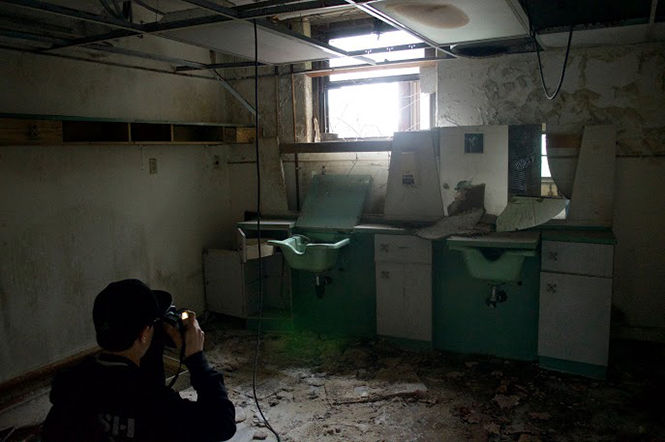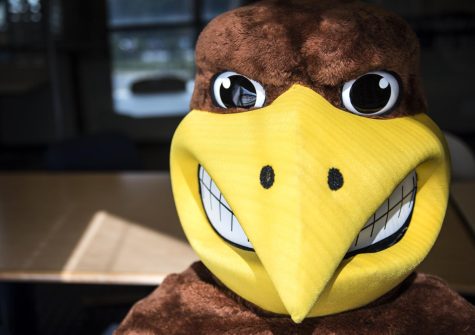Urban Photography: Exploring the decaying depths of civilization
John Ponchak, a sophomore computer science major, pauses to take a photo at the Molly Stark Mental Institution.
April 28, 2015
The floors were covered with dusty debris, and the walls were covered in layers of old, peeling paint as John Ponchak carefully walked down the empty hallway. There was no one there, but he took great care to avoid making any noise whatsoever as he made his way through the abandoned Molly Stark Mental Institution.
He stepped through one of the doorways into a small room reeking of mold and asbestos.
“Hold on a second,” he said as he crouched down to take a picture of an antique wooden box TV.
He peered through his Nikon’s viewfinder and the audible click of the shutter was heard throughout the near silent room as he captured the photo. After, he stood back up and moved on to the next room.
Ponchak, a sophomore computer science major, is a passionate photographer and adventurer. He defines himself as an urban explorer, or a person who enjoys spending his or her time exploring decaying, abandoned buildings.
“I love being in places and thinking about how people’s lives revolved around that building,” Ponchak said. “To think it meant so much to so many and see where it is now, it’s a reminder about how absolutely temporary even our greatest accomplishments are.”
In addition to being an urban explorer, Ponchak also plays guitar for local punk rock band Rothschildren and works on his own solo acoustic projects, as well.
However, it’s urban exploring, he said, that really occupies most of his time.
“It’s addictive, and the adrenaline rush you get is like no other,” Ponchak said. “You always want to keep going back because something is always different.”
A native to the Cleveland area, Ponchak said his passion for exploring began in 2011 when he was 17 years old. He recalled being bored one day with a friend and driving around Cleveland looking for something to do.
“We turned down this street, and there was this massive abandoned factory, which we later found out was called the Westinghouse Electric building,” Ponchak said. “We went in and checked it out, and instantly, I knew it was the coolest thing I’d ever done, and I never really wanted to leave.”
Paranoid of getting caught, Ponchak said that he and his friend didn’t stay long. The next day, however, Ponchak was right back in the building because he just couldn’t stay away.
After making a few more trips back, Ponchak decided to start photographing buildings he explored.
“I was actually doing photography for quite a while before that, I just never really put the two together,” Ponchak said. “I was kind of doing both of them separately, and this was what merged them together.”
Since then, his two passions of photography and adventure have spawned many more explorations as well as new appreciations for some unusual places.
“Before I visit places, I do two kinds for research,” Ponchak said. “One, on the history of the building and everything that happened there. Then, I do a search on the recent history of the building — what’s been done to it now, have other urban explorers been there or if it’s a pretty untouched building.”
Ponchak said he loves to know the history and the story behind everything. He also enjoys sharing what he learns with anyone willing to explore a building with him, acting as a sort of “unofficial” tour guide.
Ian Race, a sophomore digital media production major, has been friends with Ponchak for more than 14 years and frequently accompanies him on explorations.
“He definitely has a passion for urban exploring, and it’s evident in all his photos and vast knowledge on the subject,” Race said. “He always seems to know the background of every building we are in.”
By understanding the history, Ponchak said he has developed a deep respect for all of the places he explores and a need to preserve them — unlike some urban explorers, who, Ponchak said, like to trash and graffiti timeless buildings.
He said he attributes the growing popularity of urban exploring as the cause to this problem, as the “wrong kind of people” will find out about places urban explorers have visited and do destructive things like commit arson in the abandoned buildings.
“The national parks have this rule that you should leave nothing but footprints and take nothing but pictures,” Ponchak said. “For the most part, people should play by those rules when they go into buildings. I try to leave places as untouched as I can for other people.”
The buildings original structure, though, can sometimes pose a threat in itself as a lot of the buildings Ponchak visits have structures that have been compromised by time and the elements and are now falling apart.
“You walk in those old houses, and you just fall through the floors sometimes,” Ponchak said. “They’re abandoned, and the structures are obviously falling down and pretty unstable, making them hard to walk on.”
In addition, there is always the constant threat of having the police show up due to trespassing, but Ponchak, who frequents Cleveland and the surrounding area when exploring, said that the cops aren’t as much of an issue as homeless people are.
“This one masonic temple I went into, we tried to go in the basement, but there’s this squatter who lives there,” Ponchak said. “He just started screaming at the top of his lungs, like yelling nonsense at us. We’ve met some characters in buildings — not usually people you want to meet.”
While Ponchak favors each place for different reasons, he said the Warner and Swasey building in Cleveland is his all-time favorite because it has the best sunset view of the city’s skyline from the rooftop.
Cleveland’s House of Wills funeral homes and the Molly Stark Mental Institution near Canton are some of Ponchak’s local favorites, as well.
Recently, Ponchak has begun expanding his explorations to Pennsylvania and Virginia.
Additionally, the young urban explorer aspires to broaden his horizons even further and visit the Hudson Valley Psychiatric Hospital and the J.N. Adam Memorial Hospital, both in New York. He even wants to make a few international trips to places like Croatia because it’s home to abandoned remainders of the Soviet Union occupation as well as some of the world’s most beautiful waterfalls.
But urban exploring isn’t for everyone, Ponchak said.
“I think you have to be brave to go urban exploring,” Ponchak said. “I’ve noticed that a lot of people I go with aren’t really cut out for it because they’re are exactly how I was at first: incredibly nervous about everything and every single noise they hear. I think it takes a special kind of person to get past all that and to just be able to appreciate the place but still being aware.”
Ponchak said that he loves urban exploring because it takes a different and not necessarily “normal” person to do it. He also likes that there aren’t a ton of people doing what he does.
“Explore the world,” Ponchak said. “The best parts have the fewest people.”
Contact Jenna Kuczkowski at [email protected].
























